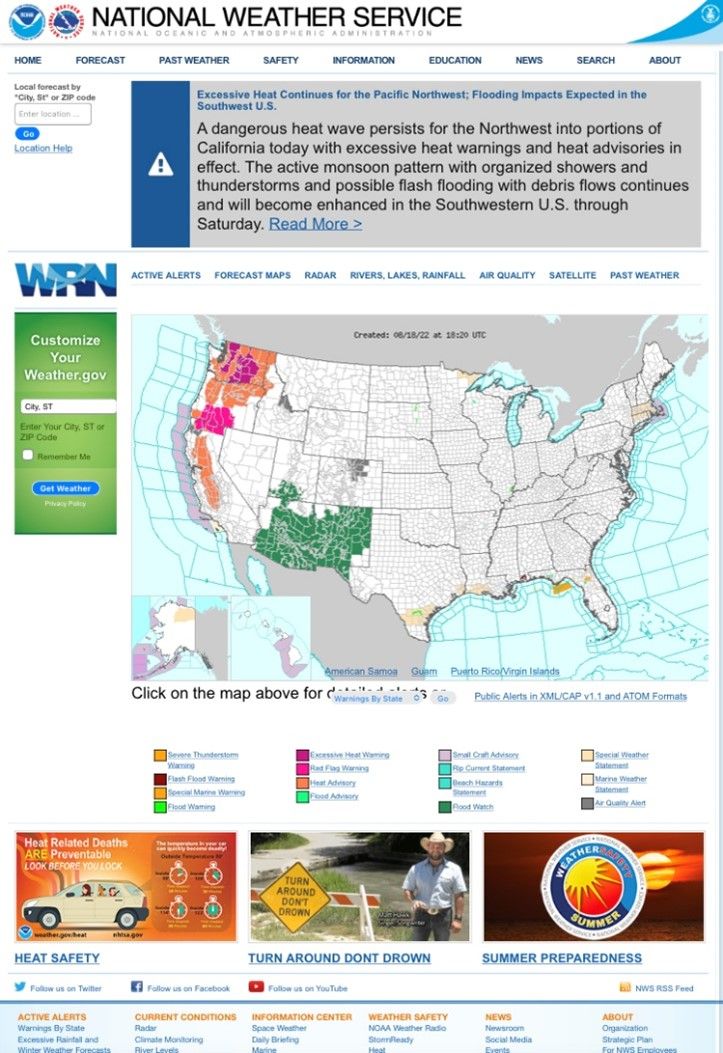
Weather.gov Is Too Popular and Useful to Look This Bad
The weather in my home Austin, Texas, this summer has been virtually indistinguishable: sunny, dry, and triple digits. In response to excessive heat like this hitting much of the nation, the Biden administration recently released HEAT.gov as a one-stop hub to help the public quickly access heat- and health-related information. A coordinated, interagency effort that offers people and organizations critical information is an accomplishment in federal IT, but it begs the question of why HEAT.gov was necessary, given that weather.gov, the federal government’s primary public-facing website for weather and climate data, is one of the most frequently visited federal websites. Perhaps the team behind HEAT.gov visited weather.gov, experienced its poor and outdated design for themselves, and decided a completely new website was required. Given weather.gov’s popularity and the increasing need for accessible, reliable weather information, it is time for the National Weather Service (NWS) to bring the site up to modern web standards.
The United States has experienced a variety of extreme weather this summer. Heat waves have swept across the contiguous 48, setting records in areas that typically enjoy mild summers. A flood in Kentucky left nearly 40 people dead. Hurricane season has begun and starts earlier every year. All-in-all, climate change continues to impact people’s day-to-day lives, and it’s vital to have reliable and accessible weather information in the event of serious and potentially catastrophic events.
Most people get weather info from their default phone app, a favored website (such as weather.gov or weather.com), or their local TV news. Much of the data these services use for their forecasting comes from the National Weather Service (NWS)—the federal agency within the National Oceanic and Atmospheric Administration (NOAA) tasked with providing weather and climate information to organizations and the public.
Because of NWS’s national network of partners and weather stations, the agency is uniquely positioned to access, analyze, and share huge amounts of climate data. As its mission suggests, NWS undoubtedly provides critical information and services for the protection of life and property.
And yet, NWS’s website, weather.gov, offers a bad user experience. There is no other way to put it. The home page’s prominent feature is a clickable map that shares weather happenings across the country, but the map is difficult to interpret and interact with. The map is peppered with color-coded hotspots that correspond to one of 17 different potential alerts, making it difficult for users to quickly glean any useful information. Moreover, the map uses nearly identical colors for different warnings, such as maroon for both “flash flood warning” and “excessive heat watch.” This poor design aligns with findings from a June 2021 ITIF report that evaluated accessibility in popular federal websites and ranked weather.gov 58th of 65 sites tested.
The map also crowds out local weather information that users must search for first before it’s displayed. The site can “remember” a location if the user selects this option, but homepage personalization (e.g., providing location-specific alerts in the banner or zooming in on the user’s state on the map) is generally lacking.
Additionally, the navigation and search functionality make exploring the site’s many pages—several of which contain useful and interesting data, maps, and other visuals—too cumbersome. Considering its central purpose as an information and safety resource, the website offers alerts and notifications insufficient real estate on the homepage. Overall, weather.gov looks and feels like a relic of the AOL-style Internet circa 1996.
Even with these usability issues, weather.gov received over 40 million visits over the last month, making it the eighth most popular federal website in that period.
NOAA and NWS can show this large customer base respect by transforming weather.gov into a modern, user-friendly website. Adopting the U.S. Web Design System (USWDS)—the federal government’s resource to build accessible, mobile-friendly websites—would go a long way in getting weather.gov up to modern web standards. (As the screenshot in Figure 1 demonstrates, weather.gov is decidedly mobile-unfriendly.) At a minimum, weather.gov should adopt noaa.gov’s interface, which offers comparatively better usability (and is mobile-accessible).
Figure 1: Weather.gov homepage on a mobile device

Ultimately, NOAA and NWS administrators and IT leaders simply need to make weather.gov modernization a strategic priority. The first goal of the NWS 2019-2022 Strategic Plan focuses on “transforming the way people receive, understand, and act on information,” but weather.gov is not even mentioned. To support this modernization effort, NOAA and NWS should access available funding channels like the Technology Modernization Fund—a government-wide working capital fund designed to modernize government IT—and coordinate with federal digital services teams, such as the U.S. Digital Service and 18F, that offer technical support to agencies for digital transformation initiatives.
In its current form, weather.gov is a disservice to its many customers. With climate change throwing meteorological curveballs across a climatically diverse country, the website is too popular and useful a resource to remain so user-unfriendly.

